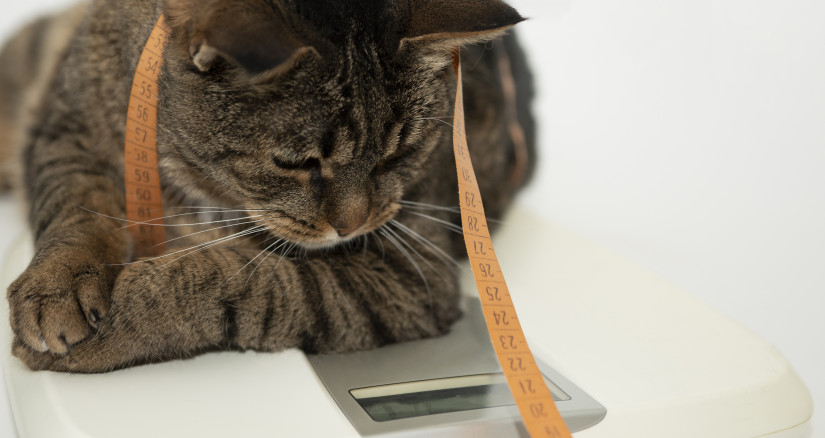
Feline Obesity: How to See it and What to do About it
In 2018, 59.5% of American cats were reported to be overweight or obese by their veterinarians.1 Obesity can increase the risk of diabetes mellitus, mobility issues, inflammation, and may even result in increased trouble breathing especially with exertion, stress, or asthma. Yet, many owners don’t recognize their cats as being overweight,2,3 and indeed even if they do, it is just so hard to stop giving foods, treats, and toppers. To many owners, food is love. But understanding what can happen to our beloved pets when the effects of all that “love” accumulate, we begin to see it as a disservice to our furry friends. In addition, cats may not associate food with love the way we do. One study reported cats to be more affectionate to their owners after initiation of a weight loss plan despite an increase in food-seeking behavior.4
For cats, the most common and severe issues associated with obesity are diabetes mellitus and mobility issues. Diabetes in cats is primarily type-2 diabetes and results from beta-cell (the cells that secrete insulin) failure due to insulin resistance from obesity. Damage to the beta cells can occur through a variety of mechanisms including inflammation, glucose toxicity, reactive oxygen species, and some mechanisms may still be unknown. Diabetes can result in dehydration, ketoacidosis, neuropathy, and likely nephropathy. It must be monitored with regular blood glucose readings, treated with at-home insulin injections, and in many cases requires hospitalization at some points, to gain control of hydration and blood glucose. It is costly, time-consuming, and heart-breaking. Given obesity and increased age are the most significant risk factors for the development of diabetes in cats, prevention and treatment of obesity is imperative to help prevent diabetes, especially as cats age.
In cats, it is estimated that 34% of lameness could be prevented if cats were lean.5 Osteoarthritis incidence increases as cats age and is reported to affect 61% of cats over the age of 6.6 It affects their ability to ambulate, groom, and is also associated with an increased incidence of cats eliminating outside of the litterbox. Pain control options are more limited than they are in dogs but may involve joint supplements taken orally or by injection, or pain medications that may have side effects. In addition, medicating cats is never fun. Since a weight reduction will decrease stress on the joints it is essential to prevent weight gain and initiate weight loss plans when cats are overweight.
The first step is to recognize what an ideal body condition is. Below is a body condition scoring chart. It is noteworthy however that owners may want to check their evaluation with that of their veterinarian since despite having access to this chart when body condition scoring, owners routinely score their cats to be leaner than they are.2,3 It’s okay! I still possess the body condition score of my 18-year-old self in my head too. That is why I need my Dr. to give me a reality check occasionally.
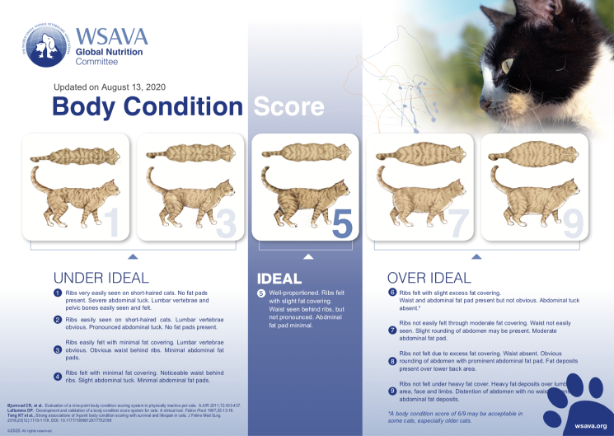
A body condition score of 4-5/9 is considered an ideal body condition. Each body condition score represents about 10% of the cat’s body weight. So, if a cat has a body condition score of 6/9 and weighs 10 lbs. then to estimate their ideal body weight, reduce their current by weight by 10%, or 1 lb., in this case. That means their estimated ideal body weight would be 9 lbs.
The next step is understanding how many calories a cat should have each day. If a cat has a body condition score of 4-5/9, and their weight is stable, then calculation of how many calories they are currently eating is one way to know that amount is appropriate. Alternatively, using a calculator like the one found at https://petnutritionalliance.org/cat.php or asking a veterinarian for help calculating the estimated ideal calorie intake for an individual pet are good options.
Lastly, remember to keep in mind all the extras. Treats, table food, toppers, and dental treats, should not add up to more than 10% of a cat’s daily caloric intake. That means if a cat should get 200 kcal per day, she can have 20 kcal from these extras each day.
But what if they are staaaarving! Consider lower-calorie diets which can be given at higher volumes. For instance, an over-the-counter maintenance diet contains 426 kcal/cup and could be given to our ideally 9 lbs. cat at ½ cup each day. Some weight management and indoor diets are lower in calories allowing the cats to get more volume for fewer calories. For instance, an over-the-counter indoor product contains 325 kcal/cup, allowing 2/3 cups per day. But be careful, some weight maintenance diets are higher in calories than their maintenance diet counterparts. The best option for weight loss for most cats is a prescription weight loss diet. Prescription weight-loss diets are more restricted in calories but higher in all other nutrient concentrations so that only energy is restricted and no other essential nutrients. For instance, one prescription weight loss diet contains 280 kcal per cup allowing the same cat to get ¾ cup each day. These diets are designed to be used with a weight loss plan so even if energy is restricted for weight loss our 9 lb. cat could still get ½- 2/3 cups each day. She would feel full even while undergoing weight loss.
Cat often have very little to think about in their indoor environment aside from when more food is coming. Therefore, mental stimulation, as well as exercise, helps to alleviate some of their concern for food. Using a food-dispensing toy, slow feed bowl, or puzzle toys to help cats work through their meal can provide important mental stimulation. There are many treat dispensers and food bowls available for this purpose but even filling the holes of a muffin tin and letting them get the food from each hole will work to slow them down. There are also small toys that can hide kibble or a treat, so the cat has to “hunt” it down.
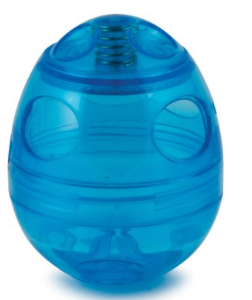
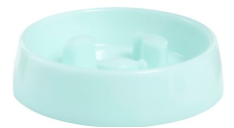

One major reason weight loss in cats is a challenge is because there is so often a chubby cat and a skinny cat in the household and sharing bowls is commonplace. It is difficult to portion out food or even know how much each cat is eating when this is the case. Training cats to eat at mealtime is possible by giving them access to food only for a certain amount of time and at certain time points throughout the day. This way food consumption can be monitored for each cat and provide them with the diet that best suits their needs. Alternatively, there are also products available that allow only certain cats into a feeding bowl.
I have also had some cats throw such a tantrum when their bowls are empty that they get aggressive or just supremely annoying to their owners. I liken this to a screaming child who is certain he needs candy even at 8:00 in the morning. (Has this ever happened in your house when Grandparents are over? No, just me?) When cats are this determined to mold their owners to their will, switching feeding to an automatic feeder is a good option. These can dispense pre-portioned or weighed-out quantities at various time points throughout the day. This way the cat will learn at what intervals they can expect food as well as that food comes from the feeder and not the owner and that throwing a tantrum at them will not get them what they want. It does take some willpower on the owner’s part at first but typically pays off in the end.
While there is so much to discuss regarding feline obesity management and prevention one more thing to consider is to keep cats moving. Our indoor feline friends just do not typically move enough. (As I write this mine is sleeping next to me.) Any way to keep them moving is helpful. This may be as simple as picking them up and moving them from their favorite spot while giving them lots of attention and putting them as far away from it as possible. They will then have to walk back to their favorite spot to return to their slumber. It may also look like hiding those toys with their kibble in them and having them hunt them down. Playing with chase toys is always a good game too. I have also had some owners who have good luck with cat wheels which allow ambitious cats to run in the house and harness training allows the cats to go for walks outside.
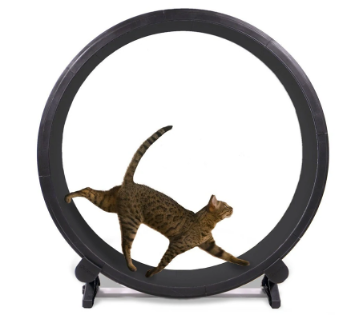
While cuddling and feeding those cute kitty companions can be so satisfying, remembering a healthy lifestyle that includes a balanced diet conservative in calories, and keeping those cats in motion will help to prevent illness and ambulation issues down the road.
References:
- Associated for Pet Obesity Prevention. 2018. Available at: https://petobesityprevention.org/2018. Accessed December 22, 2021.
- Colliard L, Paragon BM, Lemuet B., et al. Prevalence and risk factors of obesity in an urban population of healthy cats. J Feline Med Surg. 2009;11: 135-140.
- Cave NJ, Allan FJ, Schokkenbroek SL, et al. A cross-sectional study to compare changes in the prevalence and risk factors for feline obesity between 1993 and 2007 in New Zaland. Prev Vet Med. 2012;107:121-133.
- Levin ED, Erb HN, Schoenherr B, et al. Owner’s perception of changes in behaviors associated with dieting in fat cats. J Vet Behav. 2016;11:37-41.
- Scarlett JM, Donoghue S. Associations between body condition and disease in cats. J Am Vet Med Assoc 1998:212: 1725-1731.
- Slingerland LI, Hazewinkel HW, Meij BP, et al. Cross-sectional study of the prevalence and clinical features of osteoarthritis in 100 cats. Vet J. 2011; 187(3) 304-309.
Follow us on LinkedIn for the latest updates on all things happening here at BSM Partners.
About the Author
Renee Streeter is a Doctor of Veterinary Medicine and a Diplomate of the American College of Veterinary Internal Medicine (Nutrition). She obtained her Bachelor's degree in Animal Science from Cornell University and served as a farm animal nutritionist for a major feed company before attending veterinary school at Ross University. Her clinical rotations were done at Cornell University’s college of veterinary medicine, where she stayed on to do her Clinical Nutrition residency. While working in a large general practice and doing clinical nutrition consultation, Dr. Streeter also founded her own veterinary nutrition consulting company and currently helps industry clients through her position as the Nutrition Practice Principal at BSM Partners.
This content is the property of BSM Partners. Reproduction or retransmission or repurposing of any portion of this content is expressly prohibited without the approval of BSM Partners and is governed by the terms and conditions explained here.